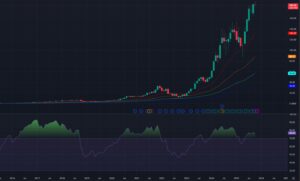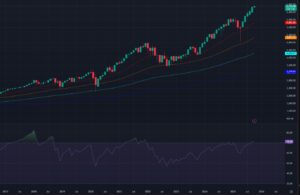The age of AI is upon us and you cannot ignore it. Now that the quest for AI superintelligence has been made official, how will this affect the crypto space?
AI trading is already fast and emotionless. But what happens when AGI (Advanced General Intelligence) and ASI (Advanced Super Intelligence) are introduced into the trading spectrum?
Here’s a hypothesis. Imagine an AGI-powered business system that tracks global systems and predicts disruptions to reallocate assets before humans even notice. Imagine it adapting to your portfolio and adjusting your risk exposure based on your goals and the macroeconomic landscape. Impressive, right?
Now increase the reach! An ASI-powered system doesn’t just trade, it reshapes markets. It can model the behavior of every participant, from retail traders to sovereign wealth funds, and generate millions of results over multiple time periods. It can detect invisible arbitrage and execute billions of trades across chains, with regulators and hedge funds relying on its knowledge.
And that is exactly what the Chinese are aiming for.
Back to last week, at China’s Hangzhou tech hub, Alibaba CEO Eddie Wu outlined the “Roadmap to Artificial Superintelligence.”
In his keynote speech, Wu specifically highlighted Alibaba’s ambitious pursuit of AGI (artificial general intelligence) and ASI (artificial super intelligence). Although researchers in this field have used this term for years, this is the first time these terms have been officially invoked.

(Source: TradingView)
“The realization of AGI – an intelligent system with human-level general cognition – now seems inevitable. Yet AGI is not the end of AI development, but its beginning,” Wu said.
This is not just a philosophical step. This is a seismic shift in how industries operate, how capital flows, and how investors allocate risk.
Morgan Stanley: AI could add $16 trillion to US stocks
According to PandoraTech News, Morgan Stanley estimates that AI could add $13 billion to $16 billion in market value to the S&P 500, up to 29%, while affecting 90% of jobs.
Full article and analysis here
PandoraTech – Unlock… pic.twitter.com/BDUCHvj0yc
– PandoraTech (@impandoratech) August 20, 2025
Stock markets, particularly in the United States, are responding with rising valuations of companies at the forefront of AI development. Nvidia, for example, has become the poster child for AI infrastructure, while Microsoft and Alphabet are being reevaluated not only as cloud providers, but also as future gatekeepers of autonomous intelligence.
EXPLORE: Next 1000X Crypto – Here are 10+ crypto tokens that can hit 1000x this year
How does AI fit into the equity landscape?
Equity markets are not ignoring the progress made in the field of AI.
Cutting-edge companies are currently engaged in a race to build increasingly autonomous systems. And the stock market responds by pumping money into the players behind this surge. Big tech companies including Nvidia, Microsoft and Alphabet have made insane gains as investors believe these companies will control the future of infrastructure, data and AI ecosystems.
2023-2024 – The AI boom.
ChatGPT + GenAI turn GPUs into digital gold.
Every startup, every Big Tech giant → looking for Nvidia chips.The stock becomes vertical. $14 → $400.#AIGrowth $NVDA pic.twitter.com/7crwSV4BjL
— Andrew Foster (@AndrewF_Writes) September 28, 2025
Since October 2022, the S&P 500 Index has surged nearly 90%, with September 2025 alone generating a 3% gain despite historic headwinds.
This push is fueled by massive capital expenditure (capex) in AI infrastructure. Big tech companies are investing billions in building data centers, buying computer chips and training AI models, driving up the stock prices of chipmakers, cloud services and software companies. (I’m looking at you, NVIDIA!)

(Source: SNP500TradingView)
At the same time, AI expectations are being priced into valuations. Nearly half of the S&P 500 is concentrated in technology, and any failure of AI to deliver on its promises could trigger sharp market corrections.
At the same time, Morgan Stanley noted that free cash flow growth among hyperscalers had turned negative. The global investment bank forecasts a 16% decline over the next 12 months.
FT published an article. AI investments are increasing among hyperscalers, a classic late-stage bubble that could burst, but construction is expected to make AI cheaper later.
Valuations close to 30x earnings or 8x sales – these prices only make sense if every part of the AI boom continues… pic.twitter.com/OElsJS9nEj
-RohanPaul (@rohanpaul_ai) October 4, 2025
Despite these concerns, the market as a whole remains optimistic. Investors hope the economy will accelerate as the Fed eases policy, boosting market action.
Overall, stocks still deliver on the promises of AI superintelligence. But the sustainability of this recovery depends on real profitability.
EXPLORE: 9+ Best High Risk, High Reward Cryptocurrencies to Buy in 2025
So how do we integrate AI into our current crypto trading scenario?
The inclusion of AI in the stock market has significantly changed the rules of the game. At its core, AI leverages machine learning, natural language processing, and real-time data analysis to make faster, informed decisions.
Some of the most effective AI strategies include AI for automated trading and sentiment analysis. Portfolio optimization is another big success. Additionally, AI bots can execute trades 24/7 based on predefined rules, remove emotional biases, and react instantly to market changes.
The rise of AI could destroy many careers over the next 5 years, with the biggest impact being for investment advisors and research analysts. I just used @zerodhaonline MCP + Claude AI to analyze my portfolio and suggest what to do. I was surprised by its rendering. Here’s how to do it pic.twitter.com/VtnOIRMYf2
– Kirubakaran Rajendran (@kirubaakaran) July 2, 2025
However, to truly succeed with AI, one must understand both cryptography and AI. Platforms like Binance, Bybit, and Mudrex offer tools that use AI to study past price trends and track market sentiment. Additionally, these tools can even help detect fraud or manipulation.
Detecting the undetectable!
AI and ML process millions of transactions at scale, analyzing behaviors, connections, and contract patterns. This allows them to quickly report anomalies, suspend risky interactions and support forensic tracing.
The future? Continuous innovation aims to… pic.twitter.com/ocVPdh8HaO
-AITECH (@AITECHio) September 21, 2025
But automation alone is not enough. A clear strategy must be put in place. AI tools work best when they are set up with a particular goal in mind, along with approved risk limits and asset choices.
Some traders use AI for high-frequency trading, that is, making rapid trades based on tiny price changes, while others use AI to scan social media and news to guess market sentiment.
Another way to grow is to use AI in decentralized finance (DeFi). Projects like Fetch.ai and Virtuals allow you to set up AI bots that handle staking, yield farming, and liquidity management. These bots can automatically adjust your portfolio, reduce fees, and even vote in governance decisions.
4/ @virtuals_io launches long, short and agricultural agents: trade, hedge and earn directly on virtuals
• Agents can now be long, short, or farmed for yield, enabling on-chain conviction and hedged strategies.
• Supports margin trading up to 3× leverage to amplify returns…– LongHash Ventures (@LongHashVC) October 7, 2025
However, one must be careful when using AI. A smart investor uses AI as a tool, not a crutch.
EXPLORE: The 12+ Hottest Cryptocurrency Presales to Buy Now
Key takeaways
-
AI superintelligence is now a formal goal, driving major changes in technology and finance.
-
Stock markets are massively funding AI infrastructure, particularly through big tech like Nvidia and Microsoft.
-
AI Adoption Growing Exponentially for DeFi Trading, Sentiment Analysis, and Automated Portfolio Management
Post ASI is coming and stocks know it. So how can you succeed with AI in crypto? appeared first on 99Bitcoins.






 2023-2024 – The AI boom.
2023-2024 – The AI boom. FT published an article. AI investments are increasing among hyperscalers, a classic late-stage bubble that could burst, but construction is expected to make AI cheaper later.
FT published an article. AI investments are increasing among hyperscalers, a classic late-stage bubble that could burst, but construction is expected to make AI cheaper later. Detecting the undetectable!
Detecting the undetectable!